Yesterday, the owners of Ann Arbor’s favorite vegan food cart, The Lunch Room, formally announced that they would be following in the footsteps of Eat, and making the transition from seasonal outdoor vendor to year-round brick and mortar. Following is my interview with Phillis Engelbert, who, together with Joel Panozzo, owns The Lunch Room.
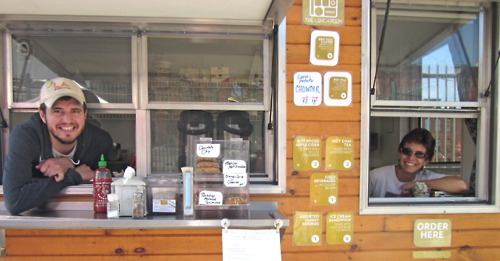
MARK: This is a big step. Why do you think now is the right time?
PHILLIS: A few reasons. First, after two seasons as a food cart, we felt we were ready. Our sales grew by 33% from year 1 to year 2 and we gained a devoted following. Second, we are ready to expand our culinary limits beyond what we can do in a food cart, with its small space and limited equipment. Vegan food also seems to be hitting its stride and entering the mainstream. When Bill Clinton goes vegan you know the chances for a vegan restaurant to succeed have never been better. We want to take the “vegan” concept and revolutionize it. No boring flavors, no pre-fab fake meats. We can take virtually any dish and make it vegan, from scratch, using fresh, wholesome, plant-based ingredients. And it will satisfy even meat-lovers.
MARK: I’m curious as to how many of your customers are vegans, and how many, like me, are just meant eaters who occasionally slip up. Do you have any sense as to the way your clientele breaks down on the omnivore-vegan continuum?
PHILLIS: I don’t have hard numbers, but from talking with people I’m guessing that most are omnivores, some are vegetarians, and just a handful are vegans. I’m basing this on how often I’ve heard from customers: “I’m not vegan, I’m not even vegetarian, I just really like your food.” We also get a lot of people who eat our food and afterwards are surprised to learn it’s vegan.
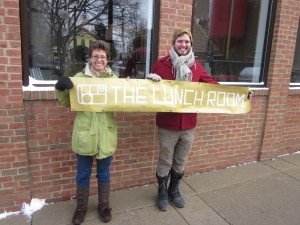 MARK: As for your comment about being able to “take any dish and make it vegan,” I’m wondering if that’s difficult to do when you’re not sampling the meat dishes your attempting to replicate and comparing them head-to-head.
MARK: As for your comment about being able to “take any dish and make it vegan,” I’m wondering if that’s difficult to do when you’re not sampling the meat dishes your attempting to replicate and comparing them head-to-head.
PHILLIS: I haven’t been a vegan my whole life — only really for the past six years or so (though I’ve been vegetarian on and off since my teenage years). So I know what meat and dairy taste like. But we aren’t trying to make things that taste like meat or cheese. We’re attempting to get that same level of satisfaction from food that people associate with its meat or dairy counterpart. Take, for instance, our barbecue tofu sliders. You still get a messy sandwich with great barbecue sauce that has something chewy and a tangy slaw inside a bun. We aren’t attempting to replicate meat per se; we’re putting a vegan spin on a dish that people know and love.
MARK: Will the lunch cart be retired now, or will you still make use if it somehow?
PHILLIS: We haven’t decided that yet. It certainly won’t be in operation on a regular basis. We may explore using it for special events.
MARK: I like the idea of the carts recirculating in the community, and allowing new food entrepreneurs to try their hand at entrepreneurship, but, I think, if I were in your shoes, I’d be tempted to keep it, and explore other opportunities, given that you’re so known for the cart. If nothing else, it would be good advertising for the restaurant… Speaking of the cart, I’m curious as to how you came by it in the first place. Did you build it? Did you buy it? Did it have a life somewhere in the U.S. before Lunch Room.
PHILLIS: We thought about operating the cart as well, but Joel and I believe in focusing our energies on one thing and doing it well. Running a food cart itself can be a 70+ hour per week gig. There’s no way we could do that and run a restaurant… The cart itself is an interesting story. We responded to an ad on Craig’s List and purchased a trailer, formerly the base of a pop-up camper, with three partially built external walls, for $550. We drove to Kokomo, Indiana, and bought it from a man named Rev. Joseph (actually, Rev. Joseph was in the hospital, so we bought it from his agent, “Danny”), who had started, but given up on, building a “Gypsy wagon” that he could take across the country, doing fortune telling in. We brought it home and, with the help of friends, finished the interior and exterior construction, plumbing, electrical, and roof, and installed all of the equipment.
MARK: How, if at all, will the menu change now that you’re expanding?
PHILLIS: The menu will grow tremendously. We have new breakfast and brunch items, entrees, salads and sides, and desserts. We have been busy developing and testing new recipes steadily since the food cart closed. We have been experimenting with “cheeses” of various flavors and consistencies made from cashews, coconut milk, tapioca, and nutritional yeast. We have four different seitan recipes that can be used in burgers, jambalaya, stir fry, and with biscuits and gravy for breakfast. Among the offerings people will see at the restaurant will be Bahn Mi, BBQ tofu, Cuban black beans, curry seitan stirfy, jambalaya, mac & cheese, nachos, Pad Thai, paella, pizza, roasted root veggie pasties, sushi, tempeh reubens, French toast, ratatouille, risotto, tacos breakfast burritos, ice cream sundaes, strawberry kiwi tarts, and gingered poached fruits. This is a select list but it gives a pretty good idea of what we’ll have.
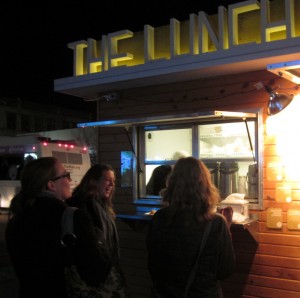 MARK: How, if at all, have you seen Ann Arbor’s food cart culture evolve since you first opened The Lunch Room?
MARK: How, if at all, have you seen Ann Arbor’s food cart culture evolve since you first opened The Lunch Room?
PHILLIS: Not much, really. There hasn’t been much activity beyond Mark’s Carts, other than vendors at Farmer’s Market and (mainly hot dog) carts around the U-M Diag. As long as commercial kitchen space remains severely limited, it’ll be hard for new food carts to get started.
MARK: How about within the tiny universe of Mark’s Carts… are things evolving and changing? Are people trying new things? I’m curious to know what you’ve learned since starting out, and how you’re adapting as a result.
PHILLIS: I can only speak for our business, since each food cart is independently owned. We constantly sought to improve our food, our menu presentation, our marketing, our hours of operation, and our customer service. We were always trying to make it a better dining experience. That said, Mark’s Carts will change this year with the addition of at least one new cart in our former space.
MARK: I realize that all of Mark’s Carts are independently owned, but I’m curious about how small changes sweep through the pod. For instance, when you started, did you think that more people would buy their food and leave… and is the fact that they’re staying changing things? Is there more of an effort to produce things that can be eaten quickly, to open up space for other customers? Are price points changing over time, as you get a sense of what people are willing to pay for items they perceive as “street” food? Are you attempting more “combination” plates, which showcase a number of different items, or has your experience showed that more people would like to sample individual items from a number of different vendors? Anything you could share about the evolutionary process would be appreciated.
PHILLIS: We found that the more accommodating we made the space at Mark’s Carts, the more people came and the longer they stayed. So we kept putting out more tables and chairs. We expanded out onto the sidewalk on Washington St., since it was closed for construction to the west of us anyways. On Friday nights we put benches out in the plaza area closer to Downtown Home & Garden. It seemed like having a crowd was a good thing — it created a buzz and a party-like atmosphere and drew more customers. This past season lot of us started using re-usable plates, cups and flatware to cut down on the cost of disposables. So that created a different atmosphere and encouraged more people to stay. In terms of price, there was a pretty large range throughout the courtyard. Customers grumbled about dishes they felt were too expensive. At The Lunch Room we prided ourselves on value — large portions for reasonable prices. We started a combo plate this year, three half-portions of any item on our menu for $8. That was tremendously popular. Same with our brunch plate: 4 items for $8. But price point is a delicate balance between what people will pay and what you need to charge in order to make a profit in this low-margin business.
MARK: Tell us about the new space in Kerrytown. I hear you’ve got some interesting architectural ideas.
PHILLIS: The space is a blank slate right now. It will undergo more demolition before we start building again. We have wonderful young architects, Lisa Sauvé and Adam Smith of the firm Synecdoche, who see it as 1,128 square feet of possibility. They are opening up the space a lot since its last incarnation, taking advantage of the natural light from two huge banks of windows on the east and west walls. We will have an open kitchen. There will be seating at the counter facing the cooking station, stool and counter seating along one wall of windows, and banquettes with two-tops along another wall, plus tables and chairs in the central area. We are planning to preserve a little of the cart’s mystique in the design and will use repurposed materials wherever possible. There will be wood slats on the ceiling for both acoustics and aesthetics, chairs with bright accent colors, and we even have our own plant artist, Andy Sell (aka Foraging Florist). Overall, our architects Lisa and Adam have an impeccable sense of taste and are designing The Lunch Room to be not just a food destination, but an architectural one.
MARK: I’m curious as to how you came to be acquainted with Lisa and Adam. Are they Lunch Room customers?
PHILLIS: Yes, the two of them were regulars at the cart. They work just two blocks from Mark’s Carts. Adam became a BBQ tofu junkie. Joel and I really clicked with them. The cart was magical that way: we came to know so many wonderful people who have become part of our lives.
MARK: I’m curious as to how you’re bankrolling the expansion. Did you raise funds from private investors? Did you work with a bank? Did you use crowdfunding again? (Two years ago, Joel and Phillis raised over $10,000 through Kickstarter to buy their food cart.) Or did you capitalize this new venture some other way?
PHILLIS: We have a bank loan to cover most of the expenses, and for the rest we are using personal funds.
MARK: Given that you were so successful with Kickstarter last time, I’m curious as to why haven’t you made use of Kickstarter, is some way, to help fund this most recent venture? Is it more work than it’s worth?
PHILLIS: Kickstarter is a lot of work but it is worth it. But it wasn’t practical for our current situation, due to the timing. We couldn’t ask all those people for money when we hadn’t secured a space and didn’t know if or when we would secure a space. But you can’t sign a lease without proof of funds. So we went the bank-loan route.
MARK: How many seats will the new place have, and when are you planning to open?
PHILLIS: There will be 36 indoor seats and 20 or more outdoors. We are planning to open by June.
MARK: Any advice for other folks thinking about getting into the food cart business?
PHILLIS: If you’re interested in starting a restaurant, a food cart is a good place to begin. Start-up costs are much lower, and you can cut your teeth as a cook and business person. But be prepared for long, hard hours, and uncertainties, like weather. And definitely learn the health department requirements before buying a cart.
MARK: What do food cart people do over the winter in Ann Arbor? Do you cater? Do you vacation together in the tropics? Do you work on your business plans, and look for restaurant spaces?
PHILLIS: I can only speak for myself and my business partner. Last year in the off-season we ran a wholesale baking business and worked on individual freelance pursuits. We also had a few reservation-only dinner events. This year, since the cart closed, we have mainly been preparing for the restaurant — looking at real estate, negotiating a lease, learning about the trade. You’d be surprised how much all that stuff takes. It’s been a full-time job.
MARK: You mention that you’ve been studying up on the restaurant business. What specifically have you done to prepare for this new venture?
PHILLIS:We have been talking to people who currently run or have run restaurants. I am reading a book called “Restaurant Success by the Numbers,” which covers everything from negotiating a lease to music and lighting in the space. We are meeting with our consultant from the Michigan Small Business and Technology Development Center and with an accountant. We are budgeting and revising our projected revenue and expense sheets, costing out food ingredients, looking at projected sales meal by meal and day by day, and planning our menus. And, my favorite part, the endless recipe development and testing.
MARK: I’ve eaten your food, but I don’t know either of you personally. Where are you from, and what brought you to Ann Arbor?
PHILLIS: We are both native Michiganders: Joel from the west side of the state and I’m from the Detroit area. We both came to Ann Arbor for school, albeit 20 years apart. You have to guess who’s older. We became friends about 7 years ago at Michigan Peaceworks, where I was the director and Joel was the graphic designer. About 4 years ago, Joel bought the house next door to me, and we have a large adjoining backyard. After various camping and canoe trips together with our respective partners and friends, and many afternoons drinking beer in the garden, plus a memorable Tarot card reading, we decided to launch a food business.
MARK: I’ve talked to a lot of entrepreneurs, but I think you’re the first to mention consulting a Tarot deck. Can you tell us more about that? Would you not have done it, if the reading had been different?
PHILLIS: Hah, that’s funny because I’m totally not a Tarot cards kind of person. It was just a whim. Joel and I were relaxing on a hot summer afternoon with our friend Celibeth, and she pulled out a deck and said she would do a reading for each of us. Having never had one before and being an adventurous type, I said sure. I was really amazed by how the cards described what was going on in my life at that time. Ditto for Joel. It also indicated to us that our futures were intertwined. And yes, I think we still would have started a food business had the reading been different. I don’t put that much stock in cards.
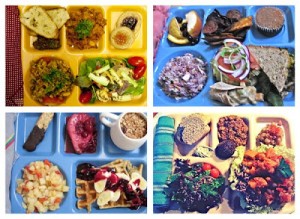 MARK: Why Kerrytown?
MARK: Why Kerrytown?
PHILLIS: It’s a happening part of town, it’s next door to the Farmer’s Market, and it’s about 1 mile from our houses. Kerrytown is walking-distance for much of the lunchtime clientele we gained at Mark’s Carts. And Kerrytown has a wonderful collection of businesses… We look forward to adding to each others’ customer base and energy. Plus, the landlords are great to work with. During our restaurant search we learned how rare that is.
MARK: How collaborative is the local food cart community? Are you sharing information with one another, helping new people get launched, etc?
PHILLIS: There is a fair amount of collaboration that goes on within the food carts. Last year, The Lunch Room helped two new carts get launched, advising them on navigating Health Department regulations, budgeting, ingredient sourcing, and the like.
MARK: Since you brought up ingredient sourcing, I’m curious to know what involvement, if any, you’ve had with the Washtenaw Food Hub folks. My sense, having talked with a number of local food entrepreneurs, is that, right now, it’s difficult to cultivate relationships with local farmers and vendors, and my hope is that Food Hub might make it easier to do so. I’m curious to know your perspective, though.
PHILLIS: Actually, they were getting started just as we were winding down for the cart season, so we haven’t intersected much. But we have business relationships with a handful of local farmers. We would place orders each week during the cart season, and pick them up at Farmer’s Market.
MARK: Where do you see food carts in Ann Arbor in another five years?
PHILLIS: I don’t know. I see the lack of commercial kitchen space as the main obstacle. If you want to do something more elaborate than hot dogs or lemonade, you need a commissary to work from. They are almost impossible to find. The city permitting system for food carts is complicated too. At Mark’s Carts we didn’t have to worry about that because we were on private property. But if you’re going to be on the street, there are rules governing selling food from parking spaces (i.e. you can’t do it). And, if you want to get a permit for sidewalk space, you need the type of cart that’s small enough to pull up on the sidewalk. Any real advancement for food carts or food trucks in Ann Arbor would have to start with commercial kitchens and an overhaul of city regulations.
MARK: Is there any political momentum to see that accomplished? Given the success that other regions have had with food carts, like Portland, I’d think that there would be more of a movement here. But, as progressive as we claim to be, I think there’s a lot of fear here about change. And I’ve also heard that local restaurants aren’t too enthusiastic about the competition… Care to comment?
PHILLIS: If there is a movement to make Ann Arbor more food-cart friendly, I haven’t heard about it. I did hear that they just passed such regulations in Traverse City which is interesting. With the national trend toward food carts and trucks, I wouldn’t be surprised if people start organizing in Ann Arbor.
MARK: Speaking of Portland, I notice that you’ve spent some time there, studying their food cart culture. What were your major take-aways having studied the carts there, and how, if at all, have you implemented the ideas at The Lunch Room?
PHILLIS: Yes, last year before the start of the food cart season Joel and I spent five days in Portland. We were primarily studying vegan food. We ate at 20 vegan food carts, restaurants, and bars. Our major takeaways were in terms of food, for instance our Saturday brunch at the cart was inspired by our experience at Portobello, a wonderful vegan restaurant. And our Southern style collard greens were inspired by a trip to the Homegrown Smoker food cart. In terms of food carts, we were surprised to learn there are over 600 in the city. It sounds like it’s easy to get licensed and health regulations are a lot more lax than they are in Washtenaw County. We also spoke to restaurant owners and found a range of attitudes toward the food carts, from those who felt the carts were drawing away their customer base to those who didn’t think it affected their business at all. But the people of Portland love their food carts and food cart culture. The carts are everywhere: grouped together in blocks, singly in vacant lots, in front of colleges. There are upscale “pods” (clusters of carts with tables and/or a canopy in the middle) and grimier, trashier areas of carts. Something for everyone.
MARK: You mention that available kitchen space is constraining the growth of our local food cart ecosystem… As I understand it, the entrepreneurs working at Mark’s Carts have access to a shared kitchen space. Outside of that, however, there’s no infrastructure… I’m curious if any attempts have been made to work collaboratively with local restaurants. Have any of them attempted to work out kitchen-sharing arrangements during off-peak hours, for instance?
PHILLIS: I know a couple of people who have had arrangements with area restaurants to use their kitchens in the wee hours of the night, but it seems rare. There is no infrastructure for that sort of thing. A food cart owner would have to seek out and follow leads and try to find something that works and, probably, have to be willing to work overnight.
MARK: You mentioned above that you could make a delicious substitute for any meat dish. I was wondering if you could give me a few tips for vegan fried chicken?
PHILLIS: I should learn not to boast, since there are probably things I couldn’t veganize. Don’t ask for liver and onions or tripe. But if you insist on vegan fried chicken, my version would start with a seitan made with flavors you associate with chicken, like garlic, onion, rosemary, thyme, oregano, bay leaves and sage, simmered in a rich vegetable broth. Then I would slice the seitan and dredge it in a pecan-cornmeal mixture with a little fresh tarragon and pan fry it until golden brown. I would serve it with a nice side of Southern-style collard greens, made delicious with sundried tomatoes, lemon juice, red wine vinegar and liquid smoke. How does that sound?
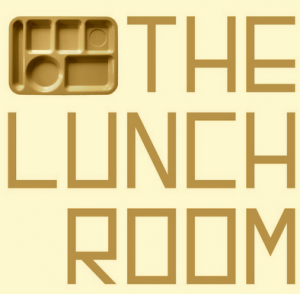 MARK: That actually sounds super awesome…. One last question. Given your association with Michigan Peaceworks, I was wondering if you might want to bring politics into the conversation, and perhaps says something about why it is, in your opinion, that vegan restaurants are important right now.
MARK: That actually sounds super awesome…. One last question. Given your association with Michigan Peaceworks, I was wondering if you might want to bring politics into the conversation, and perhaps says something about why it is, in your opinion, that vegan restaurants are important right now.
PHILLIS: I’m not into proselytizing about veganism and am not trying to convert anyone. I personally believe that a vegan diet, incorporating lots of fresh produce, is the healthiest way to eat. It is also the most environmentally friendly. But at The Lunch Room we’re not expecting customers to line up for political principles; we’re expecting them to come for the delicious food.








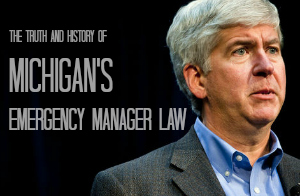



14 Comments
Woo hoo! Summer will be doubly awesome–I live fairly close by and can’t wait! Phillis and Joel are lovely people and adorable to boot!
PS: Mark, if you & Pete do one of your lunches there one day this summer, I’d better be invited :)
Here’s another challenge: vegan scrapple.
And congratulations on all of your success. I can’t wait to try the new dishes in Kerrytown.
I’m happy for them, but I feel shitty for being a lapsed vegan.
I’ve never eaten at the Lunch Room. What do people like?
What about a local mixer that puts restauranteurs in touch with food cart entrepreneurs? It seems like there should be a mechanism to hook these budding entrepreneurs with available kitchen space. And what restaurant wouldn’t want to additional revenue that would come from after-hours use?
More of this, please. And less 7-Eleven.
i’m a lunch room customer and excited for the new restaurant. best wishes.
Video of Joel and Phillis announcing their plans:
http://www.youtube.com/watch?v=Nr5wGvInNtY
I’m all for civil food cart disobedience. I say put them in parking places. I say put then on sidewalks. The future is not the past, Annarbour.
I love the lunch room. Keep up the good work!
Mark, come back to the green side. Your insides will thank you.
The Daily is on the story too!
http://www.michigandaily.com/news/lunch-room-open-kerrytown
The press juggernaut continues. Today it’s iSpy magazine.
http://mispymag.com/2013/02/the-dish-the-lunch-room/
Relevant?
Justin Timberlake promoting Veganville as a singing block of tofu
Phillis and Joel have announced their soft opening!
http://us4.campaign-archive1.com/?u=e5284fcb9cc8f3d41516c2b40&id=950cee4c5d&e=4d91980b83